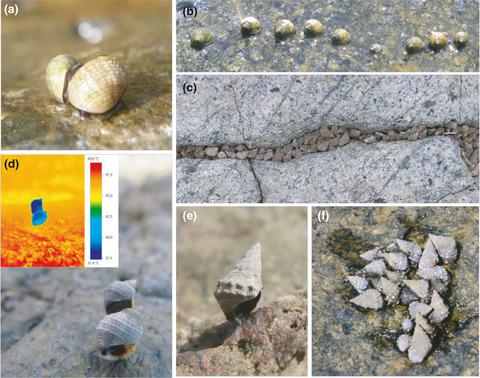当前位置:
X-MOL 学术
›
Ecol. Evol.
›
论文详情
Our official English website, www.x-mol.net, welcomes your feedback! (Note: you will need to create a separate account there.)
Behavioral repertoire of high-shore littorinid snails reveals novel adaptations to an extreme environment
Ecology and Evolution ( IF 2.6 ) Pub Date : 2021-05-02 , DOI: 10.1002/ece3.7578 Terence P T Ng 1 , Sarah L Y Lau 1 , Mark S Davies 2 , Richard Stafford 3 , Laurent Seuront 4, 5, 6 , Neil Hutchinson 7 , Tommy T Y Hui 1 , Gray A Williams 1
Ecology and Evolution ( IF 2.6 ) Pub Date : 2021-05-02 , DOI: 10.1002/ece3.7578 Terence P T Ng 1 , Sarah L Y Lau 1 , Mark S Davies 2 , Richard Stafford 3 , Laurent Seuront 4, 5, 6 , Neil Hutchinson 7 , Tommy T Y Hui 1 , Gray A Williams 1
Affiliation

|
Species that inhabit high-shore environments on rocky shores survive prolonged periods of emersion and thermal stress. Using two Hong Kong high-shore littorinids (Echinolittorina malaccana and E. radiata) as models, we examined their behavioral repertoire to survive these variable and extreme conditions. Environmental temperatures ranged from 4°C in the cool season to 55.5°C in the hot season, with strong seasonal and daily fluctuations. In the hot season, both species allocated >35% of their activity budgets to stress-mitigating thermoregulatory behaviors (e.g. standing, towering) and relatively small proportions to foraging (<20%) and reproduction (<10%). In the assumedly benign cool season, greater proportions (>70%) of activity budgets were allocated to stress mitigation behaviors (crevice occupation, aggregation formation). Both species exhibited multifunctional behaviors that optimized time use during their tidally-constrained activity window in the hot season. Females mated while foraging when awash by the rising tide, and some males crawled on top of females prior to ceasing movement to form 'towers', which have both thermoregulatory benefits and reduce searching time for mates during subsequent activity. The function of such behaviors varies in a state-dependent manner, for example, the function of trail following changes over an activity cycle from mate searching on rising tides, to stress mitigation on falling tides (aiding aggregation formation), and to both functions through tower formation just before movement stops. Many of these behavioral responses are, therefore, multifunctional and can vary according to local conditions, allowing snails in this family to successfully colonize the extreme high-shore environment.
中文翻译:

高岸沿岸蜗牛的行为谱揭示了对极端环境的新适应
栖息在岩石海岸高岸环境中的物种可以在长时间的浸出和热应力下存活下来。使用两个高港岸littorinids(Echinolittorina malaccana和ē。石蒜) 作为模型,我们检查了他们的行为清单,以在这些可变和极端条件下生存。环境温度从凉爽季节的 4°C 到炎热季节的 55.5°C 不等,季节性和每日波动较大。在炎热季节,这两个物种将>35% 的活动预算分配给缓解压力的体温调节行为(例如站立、高耸),而将相对较小的比例分配给觅食(<20%)和繁殖(<10%)。在假定的良性凉爽季节,更大比例(> 70%)的活动预算被分配给缓解压力的行为(缝隙占用、聚集形成)。这两个物种都表现出多功能行为,可以在炎热季节的潮汐限制活动窗口中优化时间使用。雌性在涨潮时一边觅食一边交配,一些雄性在停止运动之前爬在雌性身上形成“塔”,这既有调节体温的好处,也能减少后续活动中寻找配偶的时间。此类行为的功能以状态相关的方式变化,例如,从在涨潮时寻找配偶到在落潮时减轻压力(帮助聚集形成),以及通过以下方式实现这两种功能的活动周期中的跟踪变化的功能就在移动停止之前形成塔。因此,许多这些行为反应是多功能的,可以根据当地条件而变化,使这个家庭的蜗牛能够成功地在极端高岸环境中定居。这既有体温调节的好处,又可以减少后续活动中寻找配偶的时间。此类行为的功能以状态相关的方式变化,例如,从在涨潮时寻找配偶到在落潮时减轻压力(帮助聚集形成),以及通过以下方式实现这两种功能的活动周期中的跟踪变化的功能就在移动停止之前形成塔。因此,许多这些行为反应是多功能的,可以根据当地条件而变化,使这个家庭的蜗牛能够成功地在极端高岸环境中定居。这既有体温调节的好处,又可以减少后续活动中寻找配偶的时间。此类行为的功能以状态相关的方式变化,例如,从在涨潮时寻找配偶到在落潮时减轻压力(帮助聚集形成),以及通过以下方式实现这两种功能的活动周期中的跟踪变化的功能就在移动停止之前形成塔。因此,许多这些行为反应是多功能的,可以根据当地条件而变化,使这个家庭的蜗牛能够成功地在极端高岸环境中定居。跟踪跟踪活动周期中变化的功能,从在涨潮时寻找配偶,到在落潮时减轻压力(帮助聚集形成),以及在运动停止前通过塔形成来实现这两种功能。因此,许多这些行为反应是多功能的,可以根据当地条件而变化,使这个家庭的蜗牛能够成功地在极端高岸环境中定居。跟踪跟踪活动周期中变化的功能,从在涨潮时寻找配偶,到在落潮时减轻压力(帮助聚集形成),以及在运动停止前通过塔形成来实现这两种功能。因此,许多这些行为反应是多功能的,可以根据当地条件而变化,使这个家庭的蜗牛能够成功地在极端高岸环境中定居。
更新日期:2021-06-22
中文翻译:

高岸沿岸蜗牛的行为谱揭示了对极端环境的新适应
栖息在岩石海岸高岸环境中的物种可以在长时间的浸出和热应力下存活下来。使用两个高港岸littorinids(Echinolittorina malaccana和ē。石蒜) 作为模型,我们检查了他们的行为清单,以在这些可变和极端条件下生存。环境温度从凉爽季节的 4°C 到炎热季节的 55.5°C 不等,季节性和每日波动较大。在炎热季节,这两个物种将>35% 的活动预算分配给缓解压力的体温调节行为(例如站立、高耸),而将相对较小的比例分配给觅食(<20%)和繁殖(<10%)。在假定的良性凉爽季节,更大比例(> 70%)的活动预算被分配给缓解压力的行为(缝隙占用、聚集形成)。这两个物种都表现出多功能行为,可以在炎热季节的潮汐限制活动窗口中优化时间使用。雌性在涨潮时一边觅食一边交配,一些雄性在停止运动之前爬在雌性身上形成“塔”,这既有调节体温的好处,也能减少后续活动中寻找配偶的时间。此类行为的功能以状态相关的方式变化,例如,从在涨潮时寻找配偶到在落潮时减轻压力(帮助聚集形成),以及通过以下方式实现这两种功能的活动周期中的跟踪变化的功能就在移动停止之前形成塔。因此,许多这些行为反应是多功能的,可以根据当地条件而变化,使这个家庭的蜗牛能够成功地在极端高岸环境中定居。这既有体温调节的好处,又可以减少后续活动中寻找配偶的时间。此类行为的功能以状态相关的方式变化,例如,从在涨潮时寻找配偶到在落潮时减轻压力(帮助聚集形成),以及通过以下方式实现这两种功能的活动周期中的跟踪变化的功能就在移动停止之前形成塔。因此,许多这些行为反应是多功能的,可以根据当地条件而变化,使这个家庭的蜗牛能够成功地在极端高岸环境中定居。这既有体温调节的好处,又可以减少后续活动中寻找配偶的时间。此类行为的功能以状态相关的方式变化,例如,从在涨潮时寻找配偶到在落潮时减轻压力(帮助聚集形成),以及通过以下方式实现这两种功能的活动周期中的跟踪变化的功能就在移动停止之前形成塔。因此,许多这些行为反应是多功能的,可以根据当地条件而变化,使这个家庭的蜗牛能够成功地在极端高岸环境中定居。跟踪跟踪活动周期中变化的功能,从在涨潮时寻找配偶,到在落潮时减轻压力(帮助聚集形成),以及在运动停止前通过塔形成来实现这两种功能。因此,许多这些行为反应是多功能的,可以根据当地条件而变化,使这个家庭的蜗牛能够成功地在极端高岸环境中定居。跟踪跟踪活动周期中变化的功能,从在涨潮时寻找配偶,到在落潮时减轻压力(帮助聚集形成),以及在运动停止前通过塔形成来实现这两种功能。因此,许多这些行为反应是多功能的,可以根据当地条件而变化,使这个家庭的蜗牛能够成功地在极端高岸环境中定居。



























 京公网安备 11010802027423号
京公网安备 11010802027423号